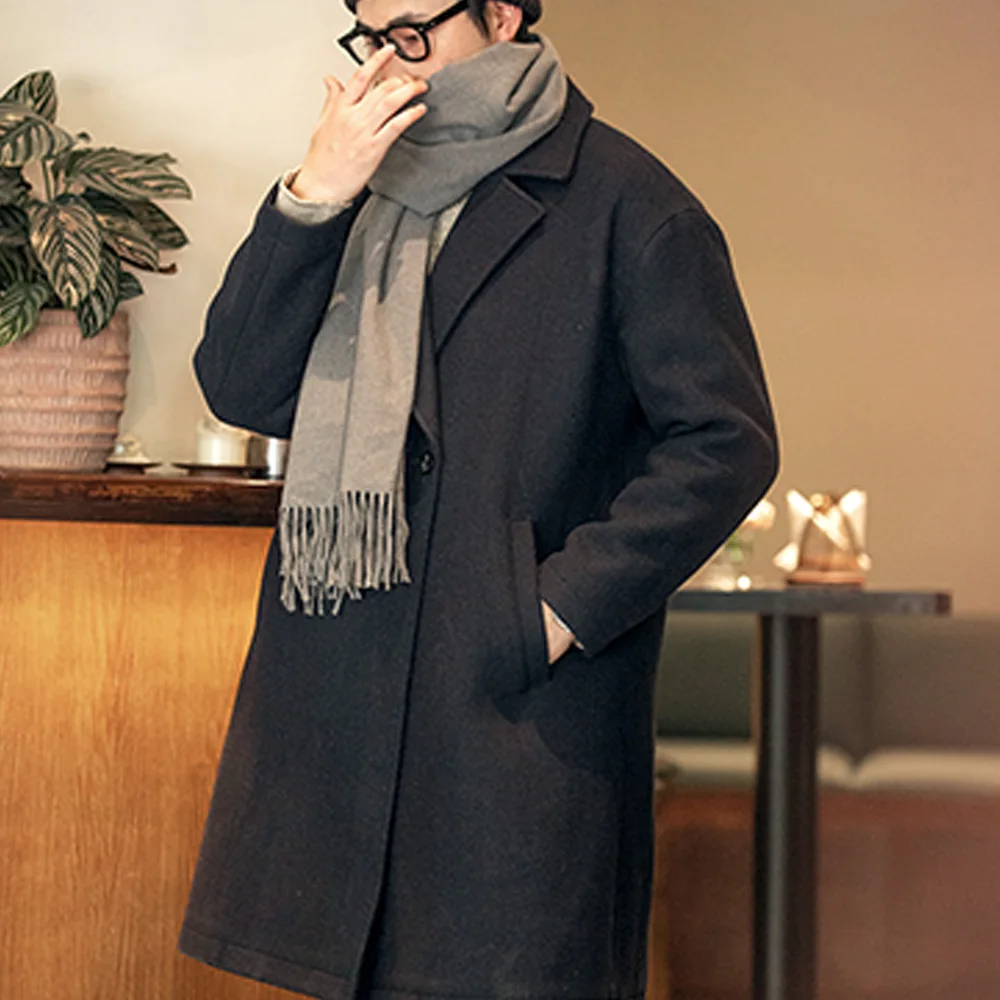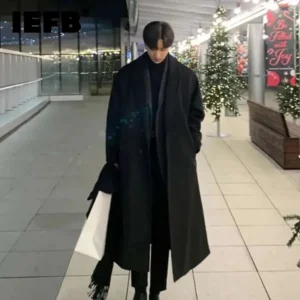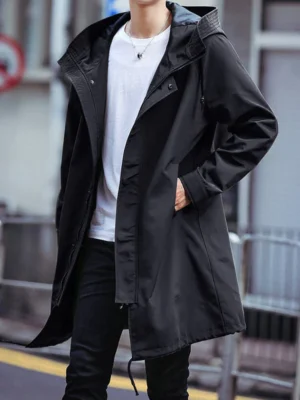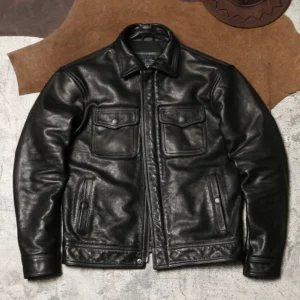Introduction to the Timeless Elegance of Herringbone Coats
The herringbone pattern stands as one of menswear’s most distinguished and enduring textile designs. Characterized by its distinctive V-shaped weaving technique that resembles the skeleton of a herring fish, this pattern has transcended centuries to remain a hallmark of refined style. Far from being merely decorative, herringbone weaves create a visual texture that adds depth and sophistication to any garment.
A herringbone coat represents the perfect marriage of form and function – offering both visual interest and practical warmth. Unlike simple solid-colored outerwear, the herringbone pattern provides subtle complexity that elevates even the most straightforward outfit. Throughout decades of changing fashion trends, the herringbone coat has maintained its position as a cornerstone piece in the wardrobes of well-dressed men.
When investing in a herringbone coat, no decision carries more weight than color selection. The right color determines not only how versatile your coat will be but also how effectively it choosing the right coat length will complement your existing wardrobe. While pattern gives character, color sets the tone for how and where your coat can be worn.
In this comprehensive guide, we’ll explore the full spectrum of herringbone coat colors – from timeless classics to distinctive alternatives – and provide you with the knowledge needed to select the perfect shade for your lifestyle, complexion, and wardrobe needs.
The Significance of Color Selection for Your Herringbone Investment
When investing in a quality herringbone coat, color selection isn’t simply about aesthetic preference – it fundamentally determines the garment’s versatility, longevity, and integration with your existing wardrobe. A thoughtfully chosen color can transform a herringbone coat from merely a winter necessity to a signature piece that defines your personal style.
Color profoundly influences how formal or casual your herringbone coat appears. Darker shades like charcoal, navy, and black naturally project formality and sophistication, making them ideal for business and formal settings. Lighter hues and warmer tones like tan or light grey tend to read more casual and approachable, perfect for weekend wear. Understanding whether herringbone is formal or casual depends greatly on your color choice.
Key considerations when selecting your herringbone coat color include:
- Versatility: How easily will it pair with your existing wardrobe?
- Formality spectrum: Will it meet your needs for business, casual, or both?
- Seasonal appropriateness: Will it work for your climate and throughout multiple seasons?
- Personal expression: Does it reflect your individual style while remaining timeless?
- Investment value: Will this color stand the test of time for years of wear?
Unlike trendier garments, a quality herringbone coat often represents a significant investment meant to last for many years. This makes color selection particularly crucial – you’re not just choosing for today but for potentially a decade or more of wear.
Classic Herringbone Colors: The Foundation of Every Sophisticated Wardrobe
Classic herringbone coat colors have earned their status through decades of enduring appeal and unmatched versatility. These timeless options – primarily grey, brown, navy, and black – form the foundation of most men’s herringbone coat collections because they seamlessly integrate into virtually any wardrobe while maintaining sophisticated presence.
These foundational colors have withstood shifting fashion trends because they balance distinctive character with timeless elegance. They serve as the standard against which all other color options are measured, offering the optimal combination of versatility, formality range, and investment value.
Whether you’re selecting your first herringbone coat or expanding your collection, understanding these classic options provides essential context for making an informed decision.
Grey Herringbone: The Ultimate Versatile Classic
Grey stands as the quintessential herringbone coat color for good reason – no other shade offers its remarkable combination of versatility, sophistication, and adaptability across different settings. While seemingly simple, grey herringbone coats come in a spectrum of variations, each with distinct characteristics and styling potential.
What makes grey particularly effective in herringbone is how the pattern’s texture enhances the color’s depth, creating visual interest without overwhelming an outfit. This allows a grey overcoat to function as both a statement piece and a versatile wardrobe foundation.
Charcoal Grey: Refined Elegance with Maximum Versatility
Charcoal grey represents the most formal and business-appropriate option in the herringbone spectrum. Its deep, rich tone projects sophistication and authority while remaining more versatile than black. The darker shade creates a slimming silhouette that flatters most body types while minimizing the visibility of any soiling or wear.
This shade excels in professional and formal settings, pairing exceptionally well with:
– Navy and grey suits for business environments
– Black trousers and white shirts for evening occasions
– Dark denim and lighter blue shirts for smart-casual settings
– Burgundy or dark green accessories for subtle color contrast
Charcoal grey herringbone particularly suits silver-toned accessories and works beautifully in winter and fall, though its versatility extends throughout the year. For many men, a charcoal grey herringbone represents the ideal first investment coat.
Mid-Grey: The Perfect Balance of Formal and Casual
Mid-grey achieves what few other coat colors can – a perfect balance between formal authority and approachable versatility. This middle ground on the grey spectrum transitions seamlessly from weekday meetings to weekend outings, making it perhaps the most adaptable of all herringbone colors.
The moderate tone offers a softer appearance than charcoal while maintaining sufficient depth for year-round wear. It pairs beautifully with:
– Navy, black, or grey trousers for business settings
– Various denim washes from indigo to light blue
– Earth tones like olive, tan, and brown for casual wear
– Both crisp whites and softer pastels in shirting
Mid-grey herringbone particularly excels during transitional seasons (spring and fall) while remaining appropriate for all but the most formal winter occasions or most casual summer events.
Light Grey/Steel Grey: Modern Sophistication for Daytime Style
Light or steel grey herringbone delivers contemporary elegance ideal for daytime wear. This brighter variant creates a distinct visual impression – more statement-making than darker greys while remaining refined and sophisticated.
Light grey herringbone brings a refreshing brightness to winter wardrobes while working particularly well in spring and fall. It pairs beautifully with:
– Navy and darker blues for striking contrast
– Pastels and lighter earth tones for spring/summer combinations
– Rich browns and tans for balanced sophistication
– Cream and off-white for elevated monochromatic looks
This shade particularly suits creative workplaces, daytime social events, and weekend wear. It tends to flatter those with lighter complexions and hair colors, though anyone can wear it effectively with the right accompanying pieces.
Brown Herringbone: Embracing Warmth and Timeless Character
Brown herringbone coats offer a warm, approachable alternative to grey while maintaining comparable sophistication. What distinguishes brown herringbone is its rich character and heritage associations – evoking traditional country aesthetics while functioning beautifully in contemporary urban settings.
The herringbone pattern particularly enhances brown tones, as the textural variation creates depth and visual interest that solid brown sometimes lacks. This allows coat length and style choices to appear both distinctive and refined in brown herringbone variations.
Dark Brown/Coffee Brown: Rich Sophistication
Dark brown herringbone delivers rich, sophisticated warmth as an excellent alternative to black for those seeking depth with approachability. This deep, coffee-toned variant offers remarkable versatility while creating a more distinctive impression than standard neutral options.
Dark brown herringbone pairs exceptionally well with:
– Navy and darker blues for timeless elegance
– Cream and off-white for striking contrast
– Forest green and olive for heritage-inspired combinations
– Dark denim and tan trousers for smart-casual perfection
The deep brown tone particularly complements warm-toned leather accessories like belts, gloves, and brown leather coats when layering. It performs beautifully across fall and winter while remaining appropriate for cooler spring days.
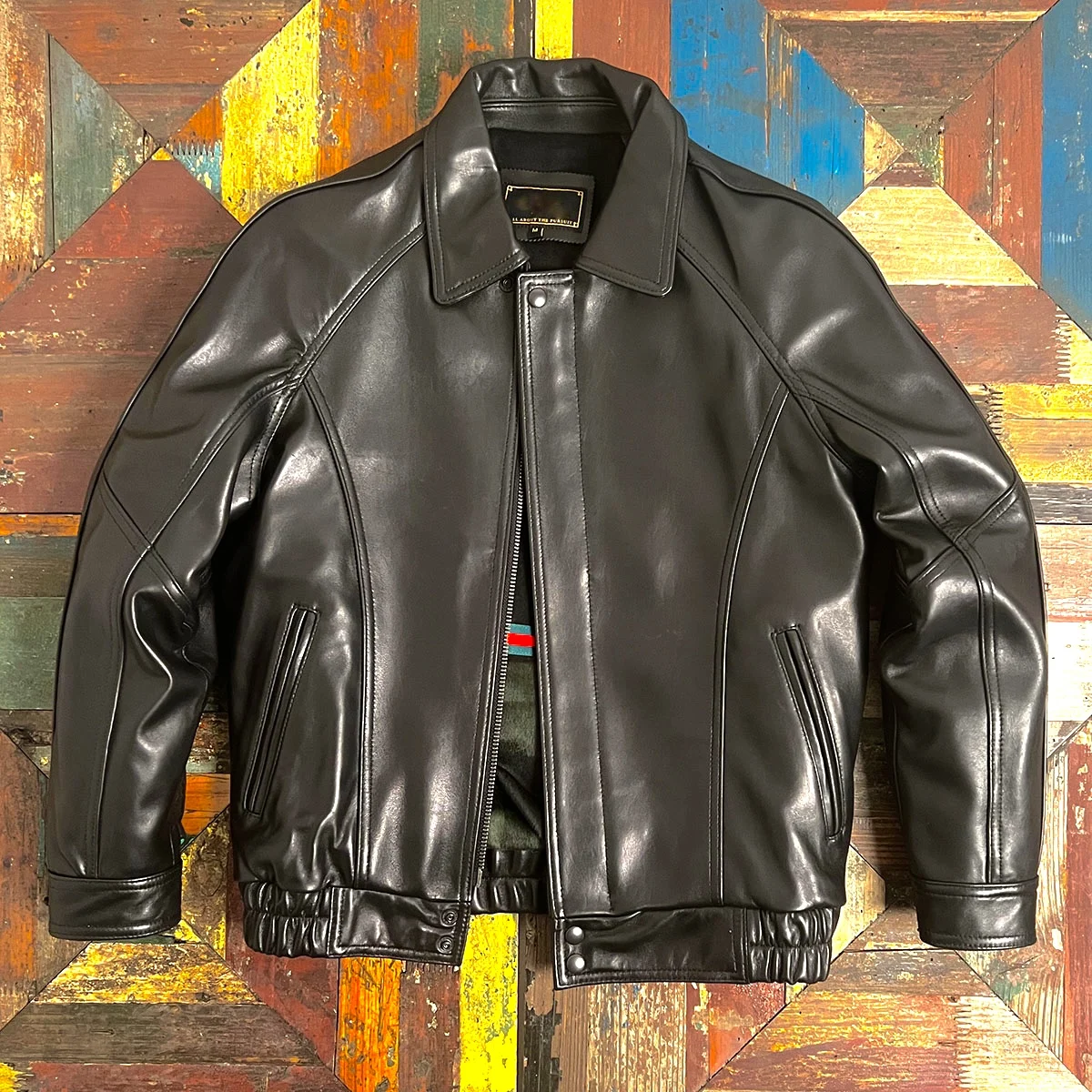
Rust Brown/Tobacco: Distinctive Character with Vintage Appeal
Rust or tobacco brown herringbone offers the most distinctive character among brown variants. This warm, mid-tone brown evokes vintage appeal and autumnal richness while maintaining versatile wearability. The color’s distinctive personality makes it ideal for those seeking something unique without sacrificing sophistication.
This rich, reddish-brown herringbone works beautifully with:
– Deep blues and navy for striking contrast
– Forest greens and earth tones for harmonious coordination
– Creams and beiges for balanced elegance
– Rustic textures like tweed and heavy knits for heritage styling
Tobacco brown particularly shines during autumn, though it works well throughout winter and cooler spring days. It excels in creative environments, country settings, and casual weekend wear while maintaining sufficient refinement for smart business-casual contexts.
Tan/Beige Herringbone: Light Sophistication for Versatile Styling
Tan or beige herringbone presents the most approachable and casual-leaning brown option. This lighter shade creates a softer impression while maintaining sophisticated elegance through the textural interest of the herringbone pattern.
Light brown herringbone offers excellent versatility with:
– White and light blue shirts for clean, fresh combinations
– Various denim washes for effortless casual style
– Navy and darker blues for classic contrast
– Other earth tones for tonal sophistication
This lighter shade performs exceptionally well during transitional seasons and in warmer climates where darker coats might feel too heavy. It particularly excels in business-casual environments, daytime social occasions, and weekend wear while offering a refreshing alternative to more common dark overcoats.
Navy Herringbone: The Understated Sophisticate
Navy herringbone delivers sleek, sophisticated elegance with greater versatility than black. This deep blue tone appears almost black in certain lights while revealing its rich depth in others, creating subtle complexity perfect for professional and formal settings.
What distinguishes navy herringbone is how the pattern highlights the color’s depth – creating visual interest through texture rather than contrast. This allows for a refined appearance that works across multiple settings without drawing undue attention.
Navy herringbone pairs extraordinarily well with:
– Grey trousers from charcoal to light
– White and light blue shirts for crisp professionalism
– Burgundy, red, and gold accessories for complementary accents
– Both black and brown leather accessories, offering unique versatility
This versatile color excels in professional environments, formal events, and smart-casual settings alike. It creates a slimming effect similar to black while offering softer contrast against most skin tones, making it universally flattering.
For those seeking a sophisticated alternative to more common grey options, navy herringbone delivers understated elegance while maintaining exceptional versatility.
Black Herringbone: Timeless Formality
Black herringbone represents the most formal option in the herringbone spectrum. While solid black can sometimes appear flat, the herringbone pattern introduces subtle texture and depth that elevates black to new sophistication. This makes black herringbone particularly effective for formal occasions and evening wear.
The stark elegance of black overcoats allows them to pair seamlessly with formal attire while creating striking contrast with lighter elements. Black herringbone works beautifully with:
– White shirts and grey suits for classic formality
– Monochromatic black and grey palettes for sophisticated minimalism
– Dark denim and lighter tops for contemporary casual edge
– Bright accent accessories that pop against the neutral backdrop
While traditionally associated with formal settings, black herringbone can be styled for contemporary casual looks when paired with the right accompanying pieces. The key to versatility with black herringbone is in the styling approach – it can transform from boardroom-appropriate to creatively contemporary through thoughtful pairing.
Beyond the Classics: Distinctive Herringbone Coat Colors
While classic colors form the foundation of herringbone coat options, several distinctive alternatives offer sophisticated character for those seeking something beyond conventional choices. These options – including green variations, burgundy/maroon, and multi-color weaves – allow for personal expression while maintaining the inherent elegance of herringbone.
These distinctive colors often work best as second or third herringbone coat purchases rather than initial investments. They complement a foundation of classic options while allowing for more personalized style expression in specific contexts.
For the confident dresser seeking to expand beyond basics while maintaining sophistication, these distinctive options offer compelling alternatives to conventional choices.
Green Herringbone: Natural Elegance with Character
Green stands as the most wearable non-classic herringbone color, offering natural elegance with distinctive character. The herringbone pattern particularly enhances green tones by creating depth and textural interest that elevates the color’s sophistication.
Green herringbone spans from subtle olive to deep forest tones, each offering distinct aesthetic qualities while maintaining surprising versatility when properly styled.
Olive Green: Rugged Sophistication
Olive green herringbone delivers earthy, versatile character with military heritage undertones. This subdued green works beautifully in casual and country-inspired contexts while offering a refreshing alternative to conventional neutrals.
Olive green herringbone pairs exceptionally well with:
– Brown and tan for natural harmony
– Denim across various washes for casual elegance
– Cream and off-white for balanced contrast
– Navy for sophisticated depth
This shade particularly excels in outdoor and casual settings, though it can transition to smart-casual environments when paired with more refined pieces. Its historical connections to military and outdoor tradition give it authenticity while remaining thoroughly contemporary.
Forest Green/Deep Green: Bold Elegance
Forest or deep green herringbone offers rich, sophisticated character for those seeking a distinctive statement. This deeper green tone balances boldness with refined elegance, creating a memorable impression while maintaining surprising versatility.
Deep green herringbone works beautifully with:
– Grey tones from charcoal to light for sophisticated contrast
– Navy for subtle depth
– Tan and camel for balanced elegance
– White and cream for striking definition
This rich green particularly shines during fall and winter, making it an excellent seasonal statement piece. It suits those seeking something unique yet still timelessly refined, offering distinction without sacrificing sophistication.
Burgundy/Maroon Herringbone: Refined Sophistication with Flair
Burgundy or maroon herringbone delivers confident sophistication with distinctive character. This rich, deep red tone creates a memorable statement while maintaining surprising versatility when thoughtfully styled. The herringbone pattern softens burgundy’s boldness by adding textural complexity that integrates it more harmoniously into various outfits.
Burgundy herringbone pairs particularly well with:
– Grey from charcoal to light for sophisticated balance
– Navy and deep blue for rich, complementary depth
– Black for dramatic, formal elegance
– Neutral tans and creams for striking contrast
This distinctive color excels in creating memorable impressions at formal events and social occasions while remaining appropriate for creative professional environments. It particularly suits those with established wardrobes seeking to add distinctive character to their collection.
Multi-Color Herringbone Weaves: Subtle Complexity
Multi-color herringbone weaves offer sophisticated complexity through subtle color blending. These special variations introduce flecks of complementary colors – like blue threads in grey herringbone or red highlights in brown patterns – creating visual interest while maintaining versatile wearability.
These multi-dimensional weaves bridge different wardrobe elements by incorporating secondary colors that connect to other pieces. For example, a grey herringbone with subtle blue threads pairs naturally with navy trousers, while brown with reddish flecks complements burgundy accessories.
When evaluating multi-color herringbone, consider:
– The dominant base color that determines overall versatility
– The subtlety of secondary colors (they should enhance, not overwhelm)
– How secondary colors complement your existing wardrobe
– The pattern scale’s effect on color perception (larger patterns show color variation more prominently)
For those seeking subtle distinction while maintaining classic versatility, multi-color herringbone offers sophisticated complexity that rewards close inspection.
Essential Considerations for Selecting Your Herringbone Coat Color
Choosing the perfect herringbone coat color requires thoughtful consideration of several practical factors beyond mere aesthetic preference. Your personal context – including your existing wardrobe, primary wearing occasions, local climate, and physical characteristics – should inform this important decision.
The following sections provide a framework for evaluating herringbone coat colors against your specific needs and circumstances. By considering these factors systematically, you can narrow down the previously discussed options to identify your ideal color choice.
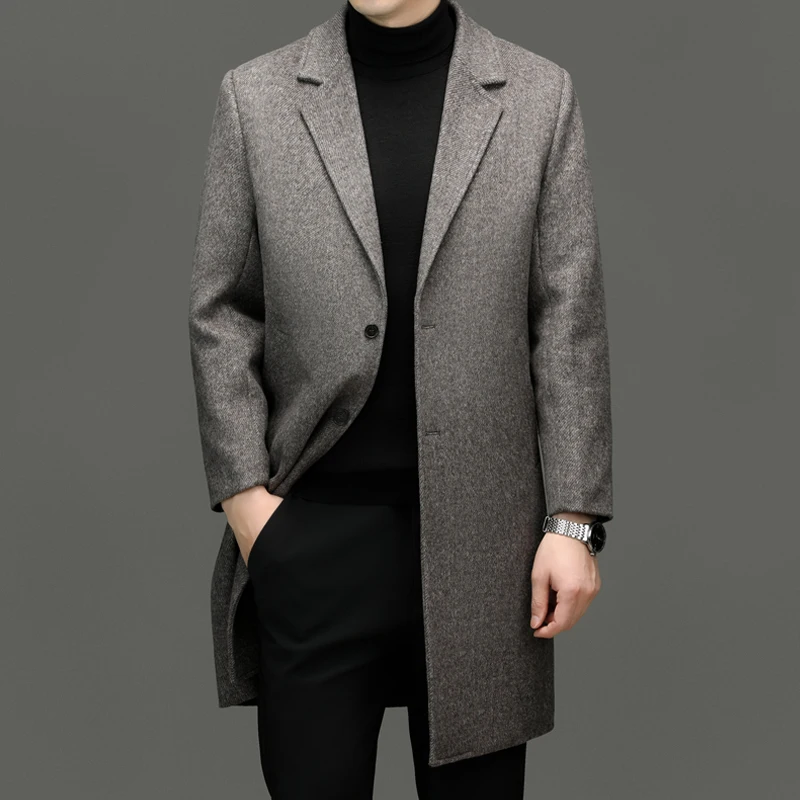
Aligning with Your Personal Style and Existing Wardrobe
The most practical starting point for herringbone color selection is an honest assessment of your existing wardrobe. Your coat should integrate seamlessly with what you already own or provide intentional contrast that enhances your overall style.
Consider these approaches based on your style personality:
- Classic dressers typically benefit from grey, navy, or dark brown herringbone that complements traditional suiting, dress shirts, and formal footwear.
- Contemporary minimalists often prefer charcoal, black, or mid-grey herringbone that creates clean lines and sophisticated simplicity.
- Creative or expressive dressers might explore olive green, tobacco brown, or even burgundy herringbone to complement their more distinctive wardrobe pieces.
To assess compatibility, mentally pair potential coat colors with your most frequently worn items. The ideal herringbone coat serves as a versatile bridge between different wardrobe elements, from formal to casual. Understanding the timeless allure of herringbone overcoats helps you make selections that will integrate with your personal style for years to come.
Occasion and Formality: Matching Color to Context
Your typical wearing contexts significantly influence optimal herringbone color selection. Consider the environments where you’ll most frequently wear your coat and the formality levels required in those settings.
For primarily business and formal use:
– Charcoal grey, navy, and black herringbone offer maximum formality
– Mid-grey provides versatility between business and social contexts
– Dark brown works well in traditional business environments with brown leather accessories
For primarily casual and weekend wear:
– Light grey, olive green, and tan/beige herringbone offer relaxed sophistication
– Tobacco brown provides distinctive character for casual settings
– Mid-grey again excels as a versatile bridge between formality levels
Many professionals benefit from selecting a herringbone color that transitions effectively between work and social settings. Assessing where you spend most of your coat-wearing time helps prioritize versatility in the right contexts.
Climate and Seasonality: Environmental Color Considerations
Your local climate and primary wearing seasons should influence your herringbone coat color selection. Different colors perform better in different environments and weather conditions.
For cold, wet climates:
– Darker colors like charcoal, navy, and dark brown show less water spotting and road splash
– Medium tones hide dust and light soiling better than very dark or very light options
– Consider practicality alongside aesthetics for daily wear
For seasonal considerations:
– Lighter colors like tan, light grey, and olive green appear more appropriate in spring and fall
– Deeper colors like charcoal, navy, and black read as more seasonally appropriate for winter
– Mid-tones like mid-grey and tobacco brown offer excellent year-round versatility
Those in variable climates should consider perfect winter coat length guidelines alongside color choice for maximum functionality. Regional weather patterns should inform both color and material selections for optimal wearability.
Complementing Your Complexion: Color Harmony with Skin Tone and Hair
Herringbone coat colors interact with your personal coloring – including skin tone, hair color, and even eye color – to create either harmony or contrast. Understanding your underlying coloring helps identify the most flattering options.
For those with warm undertones (golden, yellow, or peachy skin):
– Brown tones from dark to tan typically create natural harmony
– Olive green complements warm complexions particularly well
– Warmer greys (with brownish undertones) often work better than cooler blue-greys
For those with cool undertones (pink, red, or bluish skin):
– Grey tones, particularly charcoal and true greys, create flattering harmony
– Navy enhances cool complexions exceptionally well
– Burgundy can create striking complementary contrast
Hair color also influences optimal coat color choices. Darker hair typically pairs beautifully with the full spectrum of herringbone colors, while those with lighter hair often find mid-range tones most flattering. Those with grey or silver hair frequently discover that blue-toned greys and navy create particularly harmonious coordination.
Investment Perspective: Balancing Timelessness with Personal Expression
When considering herringbone coat colors from an investment perspective, balance timeless appeal with personal preference. Certain colors maintain their relevance decade after decade, while others may feel more trend-influenced.
From a pure investment standpoint:
– Charcoal grey and mid-grey herringbone offer unmatched longevity and versatility
– Navy provides sophisticated alternative with excellent investment value
– Dark brown delivers timeless elegance with distinctive character
– Black ensures formal appropriateness for decades of wear
For those building a herringbone collection:
– Begin with the most versatile option that matches your primary wearing contexts
– Add distinctive colors as second or third purchases once foundations are established
– Consider seasonal complementarity when expanding your collection
The substantial investment in a quality herringbone coat justifies thoughtful color selection that maximizes both immediate satisfaction and long-term value.
Pattern Scale and Fabric Weight: Technical Effects on Color Perception
The technical aspects of herringbone weaving – particularly pattern scale and fabric weight – significantly influence how colors appear and perform. These factors interact with color selection to determine the coat’s overall visual impact.
Pattern scale considerations:
– Larger herringbone patterns make colors appear more distinctive and prominent
– Smaller, tighter patterns create more subtle, refined color appearance
– Medium-scale patterns typically offer optimal versatility across different colors
Fabric weight affects color perception through:
– Heavier wool overcoats creating more substantial color presence
– Lighter weights offering more delicate color expression
– Different fiber types (cashmere vs. wool vs. tweed) affecting color vibrancy
When evaluating herringbone coats, observe how the specific pattern scale and fabric construction influence the color’s appearance. These technical aspects can make the same color appear significantly different across various garments.
Mastering Herringbone Coat Styling: Outfit Creation Guide
Once you’ve selected your ideal herringbone coat color, mastering its styling potential allows you to maximize versatility across different contexts. Herringbone’s distinctive texture provides a sophisticated foundation that works beautifully across various dress codes when paired appropriately.
The following sections offer practical styling guidance for different scenarios, helping you leverage your chosen herringbone color to its fullest potential.
Mens Black Overcoat, Mens Black Wool Coat, Mens Wool Overcoat
$339.18 Select options This product has multiple variants. The options may be chosen on the product pageMens Grey Overcoat, Mens Wool Blend Coat, Mens Wool Overcoat
$201.28 Select options This product has multiple variants. The options may be chosen on the product pageMens Herringbone Coat, Mens Long Overcoat, Mens Wool Overcoat
Price range: $197.16 through $203.69 Select options This product has multiple variants. The options may be chosen on the product pageMens Black Overcoat, Mens Long Overcoat
Price range: $100.12 through $173.24 Select options This product has multiple variants. The options may be chosen on the product pageMens Dress Coat, Mens Long Overcoat
$76.76 Select options This product has multiple variants. The options may be chosen on the product pageMens Brown Leather Coat, Mens Leather Coat
$846.94 Select options This product has multiple variants. The options may be chosen on the product page
Business and Formal Styling: Elevating Professional Attire
Herringbone coats bring sophisticated texture to business and formal environments, elevating professional attire with distinctive elegance. Your color choice significantly influences formal styling approaches.
For maximum business sophistication:
– Grey herringbone (particularly charcoal) pairs seamlessly with navy, grey, and black suits
– Navy herringbone creates striking harmony with grey suiting and white shirts
– Black herringbone offers maximum formality for important meetings and evening functions
– Dark brown herringbone complements brown and tan accessories in traditional business settings
Effective formal herringbone styling includes:
– Maintaining coherent color stories (blues with blues, greys with greys) for sophisticated harmony
– Creating intentional contrast between coat and suit for distinctive layering
– Coordinating accessories (scarves, gloves) that complement both coat and underlying attire
– Ensuring proper dress coat length for professional proportion
The textural interest of herringbone allows for slightly more creative expression in business settings than solid coats, though color choice remains the primary determinant of formality level.
Casual and Smart Casual Styling: Versatile Weekend Wear
Herringbone coats transition beautifully to casual contexts, bringing refined elegance to weekend attire. Different colors perform distinctly in casual settings, influencing the overall aesthetic.
For sophisticated casual style:
– Mid-grey herringbone pairs effortlessly with denim in any wash and casual knitwear
– Brown herringbone (especially tobacco and tan) creates heritage-inspired casual elegance
– Olive green herringbone offers distinctive weekend character with rugged appeal
– Navy herringbone dresses up casual attire for smart-casual perfection
Effective casual herringbone styling includes:
– Layering with textured knitwear like chunky sweaters, cardigans, and turtlenecks
– Pairing with quality denim or casual trousers for balanced refinement
– Selecting casual footwear from boots to premium sneakers that balances the coat’s elegance
– Using more casual accessories like knitted scarves or textured gloves
The versatility of herringbone allows it to elevate casual attire without feeling overly formal, making it ideal for sophisticated weekend wear across various settings.
Accessorizing Your Herringbone Coat: Completing the Look
Thoughtful accessories enhance your herringbone coat while extending its versatility across different occasions. The coat’s color provides crucial guidance for optimal accessory selection.
For scarves, consider:
– Complementary colors that enhance your coat (burgundy with grey, forest green with brown)
– Contrasting colors that create sophisticated pop (mustard yellow with navy, bright blue with charcoal)
– Pattern density that balances herringbone’s texture (solid or simple patterns work best)
For gloves, select:
– Leather in colors that coordinate with your shoes and belt for formal settings
– Textured wool or cashmere for casual elegance that complements the coat’s material
– Colors slightly darker than or perfectly matching your coat for sophisticated coherence
For hats, choose styles that:
– Match the formality level of your coat (fedoras for formal coats, beanies for casual styling)
– Complement rather than compete with herringbone’s texture
– Color-coordinate with either the coat or another key accessory for visual cohesion
Well-chosen accessories transform a herringbone coat from simply outerwear to a comprehensive style statement while extending its versatility across different contexts.
Color Preservation: Essential Care for Your Herringbone Coat
Protecting your herringbone coat’s color maintains its appearance and extends its lifespan as an investment piece. Different colors require specific care approaches to preserve their vibrancy and minimize wear patterns.
Essential care guidance includes:
– Regular brushing with a proper clothes brush to remove surface dust and prevent particles from embedding in the fabric
– Prompt spot-cleaning of spills and stains, which are often more visible on lighter colors
– Proper hanging on shaped wooden hangers that maintain the coat’s structure
– Seasonal storage in breathable garment bags away from direct sunlight to prevent fading
Color-specific considerations include:
– Lighter colors (tan, light grey) require more frequent cleaning and greater attention to stain prevention
– Darker colors (charcoal, navy, black) show lint and hair more prominently, requiring regular brushing
– Mid-tones (mid-grey, tobacco brown) often hide everyday wear most effectively
– Distinctive colors (burgundy, green) may benefit from professional cleaning to maintain their specific hue
With proper care, your herringbone coat will maintain its color integrity and sophisticated appearance for many years of wear.
Frequently Asked Questions About Herringbone Coat Colors
What is the most versatile color for a herringbone coat?
Mid-grey typically offers maximum versatility, transitioning seamlessly between formal and casual settings while coordinating with virtually any outfit combination. Charcoal grey provides a close second, with slightly greater formality but nearly equal versatility.
Can I wear a brown herringbone coat with black shoes?
Yes, particularly with darker brown herringbone. While traditionally brown and black were kept separate, contemporary style embraces this combination, especially when the coat and shoes are separated by other garments. Dark brown herringbone works particularly well with black shoes for business settings.
Are herringbone coats formal or casual?
Herringbone coats span the formality spectrum depending primarily on color and styling. Darker colors (charcoal, navy, black) in cleaner silhouettes read more formal, while lighter colors (tan, olive) and more textured finishes appear more casual. Most herringbone coats successfully bridge formal and casual contexts when properly styled.
How do I know if a color suits my complexion?
The most flattering herringbone colors typically either harmonize with your underlying skin tone (warm colors for warm undertones, cool colors for cool undertones) or create intentional contrast that enhances your natural coloring. When trying a coat, observe how it affects your face’s appearance – it should add vitality rather than creating a drained or washed-out effect.
Which herringbone colors work best for year-round wear?
Mid-grey, dark brown, and navy offer excellent year-round versatility. These medium-depth colors transition effectively between seasons while maintaining appropriate weight visually. The specific fabric weight matters more for seasonal appropriateness than color for these versatile options.
How do I choose between grey and navy for my first herringbone coat?
Consider your existing wardrobe and primary wearing contexts. Grey offers slightly greater versatility across different outfits, while navy creates a more distinctive impression and often appears more formal. If you wear primarily grey suits, a navy herringbone creates pleasing contrast, while those in navy suits often benefit from grey herringbone.
Finding Your Perfect Herringbone Color: Making the Final Decision
Selecting the ideal herringbone coat color ultimately requires balancing practical considerations with personal preference. After exploring the options and considerations detailed throughout this guide, trust your instincts about which color resonates most strongly with your personal style and practical needs.
For those still undecided, consider this simplified framework:
1. Identify your primary wearing contexts (formal, business, casual, or mixed)
2. Assess your existing wardrobe’s dominant color palette
3. Consider your climate and seasonal requirements
4. Factor in your personal coloring (skin tone, hair color)
5. Balance timeless investment value with personal expression
Remember that a quality herringbone coat in any of the classic colors will provide exceptional versatility and sophisticated style. The “perfect” color is ultimately the one that makes you feel confident and corresponds best with your lifestyle.
For most first-time herringbone coat buyers, mid-grey, charcoal, or navy represent the safest investment with maximum versatility. Those seeking something more distinctive might explore dark brown or olive green while maintaining excellent wearability.
Whatever color you select, understanding herringbone coat patterns ensures you’ll appreciate the sophisticated texture and timeless elegance this classic pattern brings to your outerwear collection.

